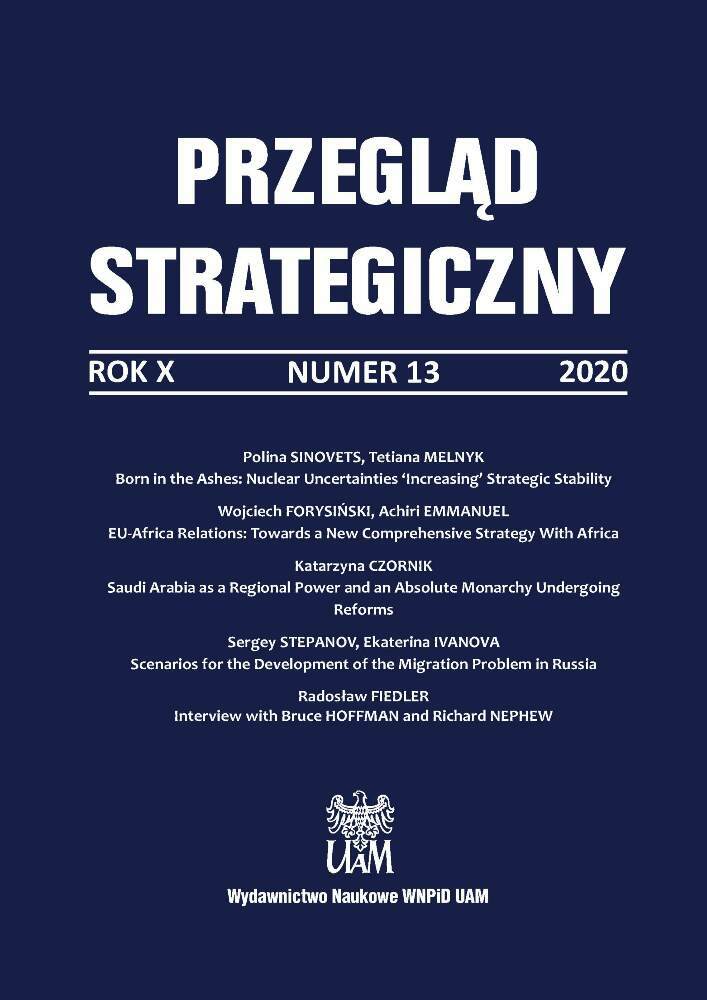Abstrakt
Przedmiot artykułu stanowią rozważania dotyczące konsekwencji Brexitu dla funkcjonowania granicy pomiędzy Irlandią a Irlandią Północną. Autor wyjaśnia, czym jest ta granica w warunkach, kiedy Wielka Brytania nie jest już członkiem Unii Europejskiej, a więc przebieg tej granicy może stanowić barierę dla swobodnego przepływu osób, towarów, kapitału i usług. Artykuł jednocześnie podkreśla, że wyjście Wielkiej Brytanii z Unii Europejskiej będzie miało istotny wpływ na zmianę funkcji tej granicy, która od tej chwili nie będzie już wewnętrzną, lecz zewnętrzną granicą Unii.
Celem artykułu jest zatem analiza konsekwencji tej zmiany z równoczesnym wskazaniem różnych modeli funkcjonowania Wielkiej Brytanii względem Unii Europejskiej oraz ich wpływu na relacje brytyjsko – irlandzkie, szczególnie w odniesieniu do różnych wymiarów przejawiania się granicy, jako bariery. Autor zastosował metodę analizy systemowej i metodę porównawczą.
Artykuł wskazuje na różne możliwe scenariusze rozwiązań, jakie w wyniku negocjacji pomiędzy Unią Europejską a Wielką Brytanią określą ich wzajemne relacje, szczególnie w odniesieniu do dostępu do jednolitego rynku europejskiego, czego z kolei implikacją będzie oddziaływanie granicy pomiędzy Irlandią a Irlandią Północną w zakresie swobody przepływu osób, towarów, kapitału i usług.
Autor stawia tezę, że w przypadku, jeśli negocjacje spowodują dość mocne rozluźnienie związków Wielkiej Brytanii z Unią Europejską, to dla złagodzenia skutków tej sytuacji dla relacji irlandzko – brytyjskich istnieje konieczność znalezienia i wypracowania bilateralnych rozwiązań, które ułatwią przekraczanie granicy. Takim rozwiązaniem może być koncepcja Smart Border 2.0.
Bibliografia
Agreement on the withdrawal of the United Kingdom of Great Britain and Northern Ireland from the European Union and the European Atomic Energy Community (2020), OJ EU L. 29/7 of 31 January.
Anderson M. (2004), Frontiers. Territory and State Formation in the Modern World, Oxford.
Balawajder G. (2017), Instytucja granic zewnętrznych Unii Europejskiej a zapewnienie bezpieczeństwa państw członkowskich w warunkach współczesnego kryzysu migracyjnego, “Pogranicze. Polish Borderlands Studies”, Vol. 5, No. 3.
Balawajder G. (2010), Zanik czy nowe funkcje granicy w Unii Europejskiej, in: Ewolucja instytucji granicy we współczesnej Europie, (ed.) S. M. Grochalski, Opole.
Barret A., Bergin A., Fitzgerald J., Lambert D., Mc.Coy D., Morgenroth E. W., Siedschlag I., Stadnicka Z. (2015), Scoping the Possible Economic Implications of Brexit on Ireland, “Economic and Social Researcher Institute”, No. 48 (November).
Bergin A., Garcia-Rodriquez A., Morgenroth E. W., Smith D. (2017), Modeling the Medium – to Long-Term Potential Macroeconomic Impact of Brexit on Ireland, “The Economic and Social Review”, No. 3 (Autumn).
Common Travel Area (2019), Home Office, Publisher for Home Office Staff on 28 February,
Crawley J. (2019), Granica urojona, “Polityka”, No. 9.
Donnelly M. (2017), UK remains Ireland’s top trading partner, despite 6pc drop in exports, “Farm Ireland”, July 27.
Grochalski S. M. (2010), Wprowadzenie do problematyki instytucji granicy państwa instytucji. Refleksje obywatela Unii Europejskiej, in: Ewolucja instytucji granicy we współczesnej Europie, (ed.) S. M. Grochalski, Opole.
Henley J. (2016), Can the UK Adopt the Norway Model’s as its Brexit Solution, “The Guardian”, December 1.
Inter Trade Ireland (2017), Potential Impact of WTO Tariffs on Cross Border Trade, June.
Ireland in brief (2020), Published by Department of Foreign Affairs, Dublin.
Mac Coille C. (2016), The economic impact of Brexit on Ireland, “Dairy Research”, March 31.
Morgenroth E. W. (2015), Economic Consequences for Ireland, The Institute of International and European Affairs, Dublin.
O’ Carrol L. (2017), How does the Irish Border Affect the Brexit Talks, “The Guardian”, June 21.
Smart Border 2.0 Avoiding a hard border on the island of Ireland for Customs control and the free movements of persons (2017), “Constitutional Affairs”, Policy Department for Citizens’ Rights and Constitutional Affairs, Directorate General for Internal Policies of the Union, PE 596.828 – November.
The Ireland Act of 2 June 1949 (2019), https://www.legislation.gov.uk (16.05.2020).
The text of the 1921 English – Irish Treaty (2019), https://treaties.un.org./doc/Publication/UNTS/LON (3.05.2020).
Trzcielińska-Polus A. (2010), Zmiany funkcji oraz zasięgu granic ugrupowań integracyjnych w Europie (ze szczególnym uwzględnieniem granic Unii Europejskiej), in: Ewolucja instytucji granicy we współczesnej Europie, (ed.) S. M. Grochalski, Opole.
Whyte J. H. (1991), Interpreting Northern Ireland, Clementon Press, Oxford.
Whyte J. H. (1983), The Permeability of the UK-Irish Border. A Preliminary Reconnaissance, “Administration”, No. 31.
Wojtaszek-Mik E., Mik C. (2005), Dorobek Schengen, in: Unia Europejska. Wspólnota Europejska. Zbiór dokumentów, (eds.) E. Wojtaszek-Mik, C. Mik, Zakamycze.
Wordin A. (2018), Ireland and the Economic Impact of Brexit, “Pepperdine Policy Review”, Vol. 10, 3 February.

